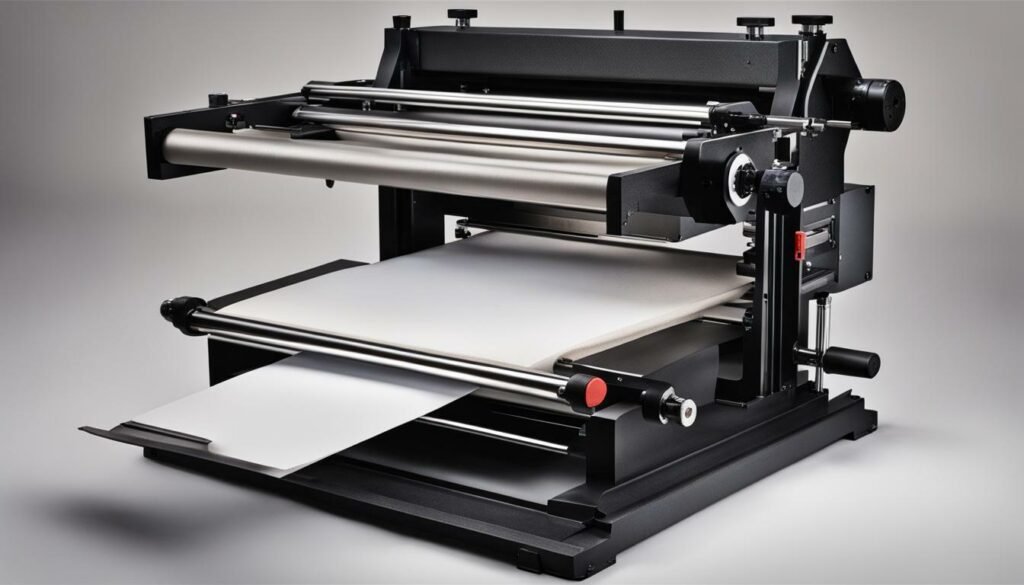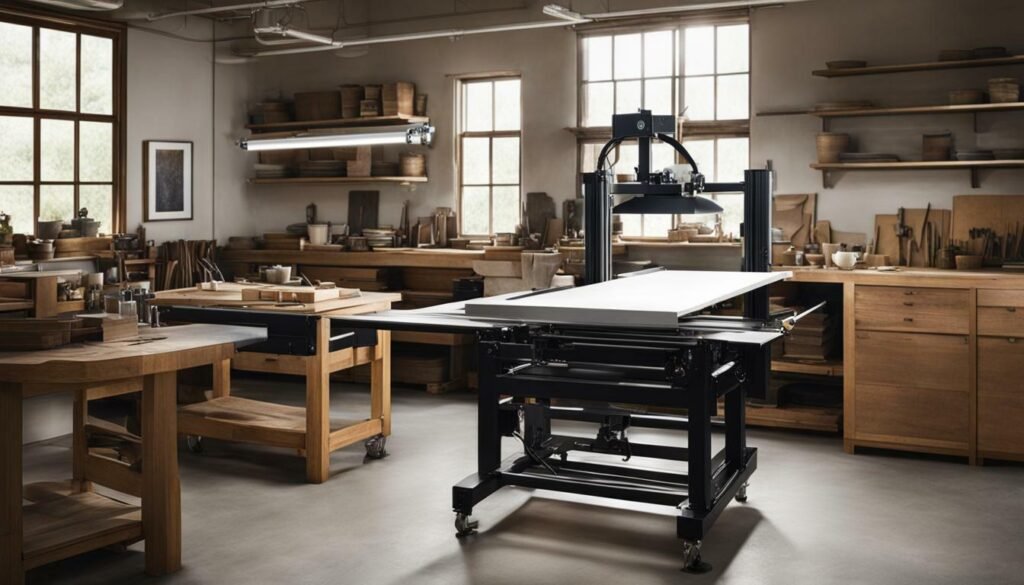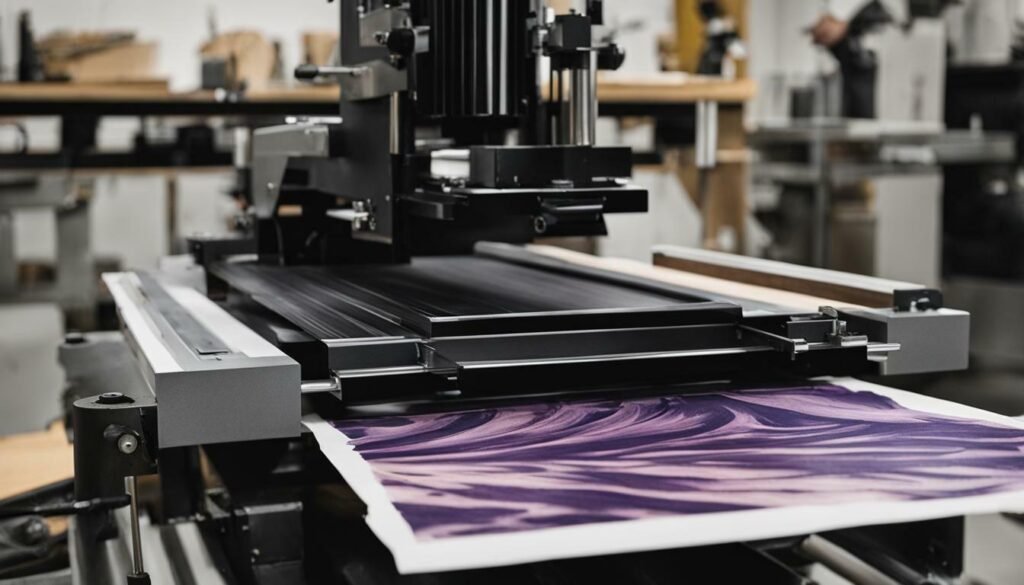If you’re a printmaking enthusiast, you know that having a reliable press is essential to bringing your creations to life.
Our guide will take you through every step of the process, from choosing the right equipment to troubleshooting common issues. With our help, you’ll achieve press perfection and create stunning prints in no time.
- Setting up a printmaking press requires careful consideration of equipment, location, and preparation.
- Having the right tools at hand will set you up for success and make the setup process smoother.
- Selecting the right location for your printmaking press is essential for ventilation, space, lighting, and access to water.
- Assembling your printmaking press involves following the manufacturer’s instructions carefully and ensuring everything is secure and properly aligned.
- Preparing plates and inks, choosing paper, setting pressure and positioning, and applying ink techniques are all essential components of the printing process.
Getting Started with the Right Equipment
Before you dive into setting up your printmaking press, it’s crucial to ensure that you have all the necessary equipment. Having the right tools at hand will help make the setup process smoother and more efficient.
Here are the essential printmaking press equipment you’ll need:
- A printmaking press
- Plates
- Inks
- Paper
- Carving tools

Depending on your preferences and artistic goals, you may also need additional equipment, such as:
- Brayers or rollers
- Registration boards
- Inking plates or palettes
- Etching presses
- Screen printing materials

Choosing the Perfect Location
Ensure the area is well-ventilated, providing a comfortable working environment.
- Consider the size and weight of your press when deciding on the spot.
- Adequate lighting is also necessary to work comfortably, allowing you to see your work clearly.
- Finally, access to water will facilitate cleanup and maintain a clean workspace.
- Choose a well-ventilated area for comfortable work
- Consider the size and weight of your press when selecting the spot
- Ensure adequate lighting to work with ease
- Access to water will facilitate cleanup and maintain a clean workspace.
Assembling Your Printmaking Press
Now that you have gathered all the necessary equipment, it’s time to assemble your printmaking press. Follow the manufacturer’s instructions carefully and take your time to ensure everything is set up correctly.
Here are some essential steps to keep in mind:
- Start by attaching the base of your press, ensuring it’s flat and even on the ground.
- Attach the rollers by sliding them onto the axels, securing them with bolts or screws.
- Next, place your plates on the press bed and make sure they’re aligned correctly.
- Add pressure to the press bed by tightening the pressure screws gradually.
- Test the pressure by placing some paper on the plates and rolling the press. Adjust the screws until you achieve the desired pressure.
- Make sure all components are secure and properly aligned before proceeding with your first print.
Before you can start creating your prints, it’s essential to prepare your plates and inks correctly. Below are some steps to follow to achieve the best results:
- Clean your plates thoroughly to remove any dust or debris that may interfere with the print quality.
- Apply a thin, even layer of ink to the plate, ensuring that the ink covers the entire surface uniformly.
- Test the ink consistency by doing a test print on a scrap piece of paper and make any necessary adjustments to achieve the desired effect.
Paper Selection and Preparation
Choosing the right paper is a crucial step in creating high-quality prints. Consider the texture, absorbency, and thickness of the paper you are using. Here are some tips:
- Thicker paper is ideal for prints with more detail, while thinner paper works well for prints with less intricate designs.
- Textured paper can add depth and character to your prints, while smoother paper can create a more polished look.
- Test your ink on each type of paper before printing to ensure the ink adheres well and creates crisp lines.
Once you’ve selected the perfect paper, it’s time to prepare it for printing:
- Cut the paper to the desired size using a clean, sharp knife or paper cutter.
- If your paper is wrinkled, gently iron it on the lowest heat setting possible to smooth out any creases. Alternatively, you can place it under a stack of heavy books overnight.
- Be sure to keep your paper clean and free of any debris or smudges that could affect the final print.
Now that your printmaking press is assembled and the plates and inks are prepared, it’s time to set the pressure and positioning for optimal printing. Follow these steps:
- Experiment with different pressure settings until you achieve the desired outcome. Too little pressure may result in faint prints, while too much pressure can create unwanted texture or smudging.
- Position the plates and paper carefully to ensure proper alignment and avoid mistakes. Practice on scrap pieces before committing to your final print.
- Be mindful of the direction you feed your paper into the press. Each press may require a different technique, so consult the manufacturer’s instructions.
Keep in mind that this step may require some trial and error. Don’t be afraid to adjust and experiment until you find the perfect balance. The satisfaction of a well-executed print is worth the effort and practice.
Ink Application Techniques
Experimenting with various ink application techniques is a fun and creative way to produce unique prints. Here are some techniques to try:
- Rolling: Apply ink to the plate using a roller, ensuring an even coating. Roll in different directions to create various textures.
- Dabbing: Use a soft cloth or sponge to dab ink onto the plate, creating a speckled or mottled effect.
- Brushing: Use a brush to paint the ink onto the plate, creating a more precise and controlled application.

Printing Process Step-by-Step
Now that you’ve assembled your printmaking press and prepared your materials, it’s time to start printing! Follow these step-by-step instructions for a successful printing process:
- Prepare the press by ensuring it’s securely anchored, and the rollers are level and free from debris.
- Align the plates and paper carefully, ensuring they’re correctly positioned and straight.
- Apply the desired pressure by adjusting the press screws or pressure gauge.
- Roll the press smoothly and carefully in one direction. Pause briefly after each turn to ensure the paper and plates are positioned correctly.
- Inspect the print and make any necessary adjustments to the pressure or alignment before printing the final product.

Even with proper setup, you may encounter common issues with your printmaking press. Here are some tips on how to troubleshoot them:
- Uneven inking: Ensure that the ink is applied evenly on the plate and that the roller is properly aligned. Check if the plate is clean and free from debris.
- Plate slippage: Check that the plate is properly secured on the press and adjust the pressure as needed.
- Paper wrinkling: Use a thicker paper or adjust the pressure to prevent wrinkling.
Maintaining your printmaking press is essential to ensure optimal performance and longevity. Here are some tips to keep it in top shape:
- Wipe down the press after each use with a soft cloth and mild soap and water to remove any ink or debris.
- Apply a light coat of lubricant to moving parts, such as the rollers, to prevent rust and maintain smooth operation.
- Regularly inspect the press for any signs of wear or damage, such as cracks or dents, and address them promptly to avoid further issues.
- Store the press in a dry and clean environment to prevent dust and moisture from accumulating.
- Keep carving tools clean and sharp to avoid damaging plates or injuring yourself.
Your printmaking press setup is complete, and you’re ready to unleash your artistic potential. Here are some additional tips and techniques to enhance your printmaking experience:
- Experiment with different types of paper to create unique textures and effects on your prints. Try handmade paper for a rustic feel or metallic paper for a touch of glamor.
- Explore color mixing with inks to create custom shades and gradients. Start with the primary colors and experiment with different combinations to achieve your desired hues.
- Try alternative materials for plate creation, such as linoleum or foam blocks. These materials can offer varied textures and design possibilities.
- Don’t be afraid to embrace your creativity and push the boundaries of traditional printmaking. Use the press to create other types of artworks such as collages, monotypes, or mixed media pieces.
Safety should always be a top priority when setting up and using your printmaking press.
- Wear protective gear such as gloves and goggles to prevent injuries from sharp tools or chemicals.
- Properly handle and store inks, cleaning chemicals, and other hazardous materials.
- Ensure that your press is stable and secure before use to avoid accidents or injuries.
- Have a first aid kit nearby and familiarize yourself with emergency procedures in case of an accident.
In addition to potential issues with your printmaking press, you may also encounter problems with other equipment, such as carving tools or inking plates. Here are some common printmaking press troubleshooting techniques to help you address these issues:
- Carving tools not cutting properly? Try sharpening the blades or using a different tool for the job.
- Uneven inking on the plates? Make sure you’re applying ink evenly and consistently, using a brayer or brush to spread the ink as needed.
- Plate slippage during printing? Check that the plates are properly aligned and secure on the press before printing.
- Paper wrinkling or tearing during printing? Adjust the pressure of your press or try a different type of paper to prevent damage.
- Inconsistent ink coverage? Experiment with different inking techniques and adjust the amount of ink used on each pass.
Now that you’ve successfully set up your printmaking press, it’s time to celebrate and let your creativity shine! The possibilities of what you can create with your press are endless, so embrace the joy of printing and explore new techniques and styles.
Below, we’ve compiled some additional tips and suggestions to help inspire you on your printmaking journey:
- Experiment with different types of paper to see how they affect the final print.
- Try different inks, color mixing, and alternative materials for plate creation to expand your printing capabilities.
- Consider attending workshops or classes to learn new techniques and connect with other printmakers.
- Share your prints on social media or in local art shows to showcase your unique style and gain inspiration from others.
- Don’t be afraid to make mistakes and learn from them – sometimes, the most unexpected results can lead to new discoveries.
FAQ
What equipment do I need to set up a printmaking press?
To set up a printmaking press, you will need a press, plates, inks, paper, and carving tools.
How do I choose the perfect location for my printmaking press?
Look for a well-ventilated area with ample space to move around. Consider the weight and size of your press. Ensure there’s enough lighting and access to water for cleanup.
How do I assemble my printmaking press?
Follow the manufacturer’s instructions carefully. Start by attaching the base and then proceed with adding the rollers, plates, and other components.
How do I prepare the plates and inks for printing?
Clean the plates thoroughly and apply a thin, even layer of ink. Test the ink consistency and make any necessary adjustments.
What should I consider when choosing the paper for my prints?
Consider factors such as thickness, texture, and absorbency. Trim the paper to the desired size and ensure it’s clean and free from any debris.
How do I set the pressure and positioning on my printmaking press?
Experiment with different pressure settings and test prints until you find the optimal balance. Pay attention to the position of your plates and paper to avoid misalignment.
What are some ink application techniques I can try?
Explore various techniques such as rolling, dabbing, or brushing the ink onto the plates. Practice different methods to find what suits your artistic style best.
Can you provide a step-by-step guide for the printing process?
Prepare the press, align the plates and paper, apply the desired pressure, and smoothly roll the press. Practice and refine your technique for consistent prints.
What are some common issues I may encounter with my printmaking press?
Common issues include uneven inking, plate slippage, or paper wrinkling. Learn how to troubleshoot these problems for flawless prints.
How should I maintain and care for my printmaking press?
Clean the press after each use, lubricate moving parts, and inspect for wear or damage. Regular maintenance will extend its lifespan and maintain print quality.
Are there any additional tips and techniques for printmaking?
Experiment with different paper types, explore color mixing with inks, and try alternative materials for plate creation. Embrace creativity and push the boundaries of your artistry.
What safety precautions should I take when using a printmaking press?
Always wear protective gear such as gloves and goggles. Follow proper handling procedures for inks and cleaning chemicals. Have a first aid kit nearby and know emergency protocols.
What if I encounter issues with other printmaking equipment?
In addition to troubleshooting your press, learn how to identify and resolve problems with carving tools or inking plates for a smooth printmaking process.
How can I celebrate my printmaking journey?
Congratulations on setting up your printmaking press! Embrace the joy of creating unique prints and continually explore new techniques and styles. Let your creativity shine and enjoy the journey.
